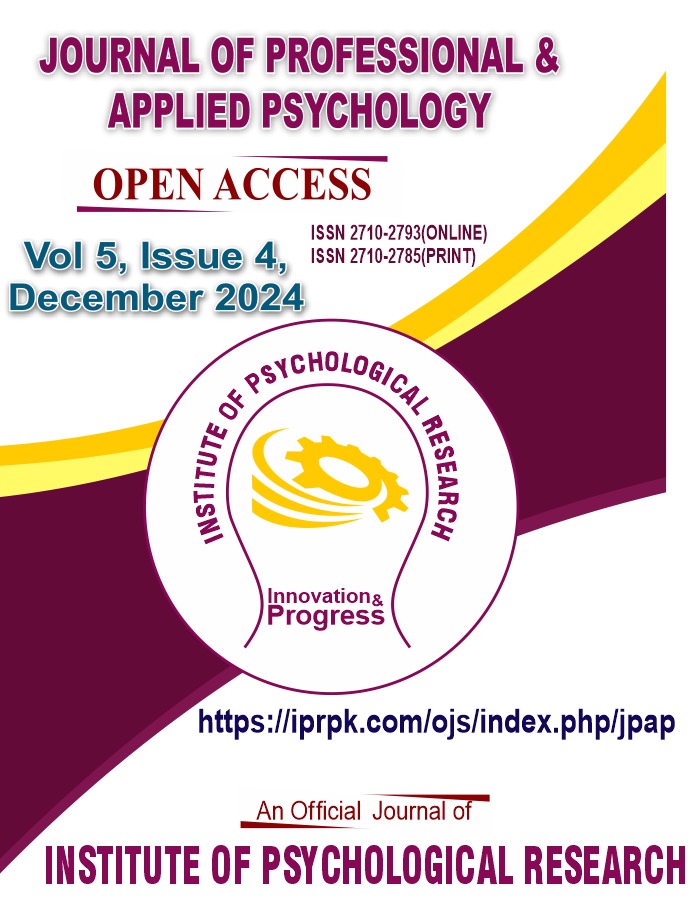Emotional Intelligence and Compassion Fatigue in Nurses: Mediating Role of Ego Resilience
DOI:
https://doi.org/10.52053/jpap.v5i4.349Keywords:
Compassion Fatigue, Ego Resilience, Emotional Intelligence, NursesAbstract
The previous studies documented that nurses are at most risk population for work related stress. Therefore, the objectives of current study were to examine the connection between emotional intelligence, ego resilience and compassion fatigue in nurses. A cross-sectional research design was adopted to recruit 120 female nurses purposively. The standardized assessment tools used in this study were Emotional Intelligence scale (EIS), Ego Resiliency scale (ERS) and Professional Quality of Life (ProQOL) scale. The statistical software employed to analyze all the collected data was SPSS version 26 and Hayes Macro Process version 4.0. Results demonstrated significant positive association of emotional intelligence with ego resilience (r =.32, p<0.001) and compassion satisfaction (r =.25, p<0.001). Similarly, emotional intelligence was positively predicting compassion satisfaction (? =.18, p<0.05) and significantly negatively predicting burnout (?= -.20, p<0.05) and secondary traumatic stress (?= -.27.18, p<0.001). Mediation analysis indicates that ego resilience (? =.10, LL=.03, UL =.18) was mediating a relationship between emotional intelligence and compassion satisfaction in nurses. All findings are discussed along with relevant literature.
References
Alessandri, G., Vecchio, G. M., Steca, P., Caprara, M. G., & Caprara, G. V. (2010). Ego Resiliency Scale--Revised (ER89-R) [Database record]. APA PsycTests.https://doi.org/10.1037/t01609-000
Almeneessier, A.S., & Azer, S.A. (2023). Exploring the relationship between burnout and emotional intelligence among academics and clinicians at King Saud University. BMC Medical Education, 23, 673. https://doi.org/10.1186/s12909-023-04604-7
Alonazi W. B. (2020). The impact of emotional intelligence on job performance during COVID-19 crisis: a cross-sectional analysis. Psychology Research and Behavior Management, 13, 749–757, https://doi.org/10.2147/PRBM.S263656
Amir, K., Betty, A., & Kenneth, A. (2019). Emotional Intelligence as Predictor of Compassion Fatigue among Mental Health Practitioners. Open Access Library Journal, 6, 1-10. doi: 10.4236/oalib.1105410
Block, J., & Kremen, A. M. (1996). IQ and ego-resiliency: Conceptual and empirical connections and separateness. Journal of Personality and Social Psychology, 70(2), 349–361. https://doi.org/10.1037/0022-3514.70.2.349
Campbell-Sills L., & Stein, M. B. (2007). Psychometric analysis and refinement of the Connor-Davidson resilience scale (CD-RISC): validation of a 10-item measure of resilience. Journal of Trauma and Stress, 20(6), 1019–1028. doi:10.1002/jts.20271
Castelino, P., & Mendonca, T. (2021). Emotional intelligence in nursing: The heart of the art a review. Journal of Complementary and Alternative Medical Research, 14(3), 1–6. doi:10.9734/JOCAMR/2021/v14i330244
CDC. (2023). Healthcare Workers and Work Stress.https://www.cdc.gov/niosh/topics/healthcare/workstress.html
Cohen, S., Janicki-Deverts, D., Doyle, W.J., Miller, G.E., Frank, E., Rabin, B.S., & Turner, R.B. (2012). Chronic stress, glucocorticoid receptor resistance, inflammation, and disease risk. Proceeding of National Academy of Sciences, 109, 5995–5999. doi:10.1073/pnas.1118355109.
Collado-Soler, R., Trigueros, R., Aguilar-Parra, J. M., & Navarro, N. (2023). Emotional intelligence and resilience outcomes in adolescent period, is knowledge really strength? Psychology Research and Behavior Management, 1365-1378. doi:10.2147/PRBM.S383296
Cook A., Sigler C., Allen L., Peters J.A., Guthrie C., Marroquin M., Ndetan H., Singh K.P., Murry J., Norwood S., et al. (2021). Burnout and anxiety among trauma nursing specialties in a rural level I trauma center. Journal of Trauma Nursing, 28, 26–36. doi:10.1097/JTN.0000000000000554
Droppert, K., Downey, L., Lomas, J., Bunnett, E. R., Simmons, N., Wheaton, A., Nield, C., & Stough, C. (2019). Differentiating the contributions of emotional intelligence and resilience on adolescent male scholastic performance. Personality and Individual Differences, 145, 75–81. https://doi.org/10.1016/j.paid.2019.03.023
Drury, V., Craigie, M., Francis, K., Aoun, S., & Hegney, D.G. (2014). Compassion satisfaction, compassion fatigue, anxiety, depression and stress in registered nurses in Australia: Phase 2 results. Journal of Nursing and Management, 22, 519–531. doi: 10.1111/jonm.12168
Duarte, J., & Pinto-Gouveia, J. (2016). Effectiveness of a mindfulness-based intervention on oncology nurses’ burnout and compassion fatigue symptoms: A non-randomized study. International Journal of Nursing Studies, 64, 98–107. doi:10.1016/j.ijnurstu.2016.10.002
Dugué, M., Sirost, O., & Dosseville, F. (2021). A literature review of emotional intelligence and nursing education. Nurse Education in Practice, 54, 1–10. doi: 10.1016/j.nepr.2021.103124
Fiorilli, C., Farina, E., Buonomo, I., Costa, S., Romano, L., Larcan, R., & Petrides, K. V. (2020). Trait emotional intelligence and school burnout: the mediating role of resilience and academic anxiety in high school. International Journal of Environmental Research and Public Health.17:1–9. doi:10.3390/ijerph17093058
Gelkop, C., Kagan, I., & Rozani, V. (2022). Are emotional intelligence and compassion associated with nursing safety and quality care? A cross?sectional investigation in pediatric settings. Journal of Pediatric Nursing, 62, e98–e102. doi: 10.1016/j.pedn.2021.07.02
Geun, H. G., & Park, E. (2019). Influence of emotional intelligence, communication, and organizational commitment on nursing productivity among Korean nurses. Journal of Korean Academy of Community Health Nursing, 30 (2), 226-233. https://doi.org/10.12799/jkachn.2019.30.2.226,2-s2.0-85073760205
Hegney, D. G., Craigie, M., Hemsworth, D., Osseiran-Moisson, R., Aoun, S., Francis, K., & Drury, V. (2014). Compassion satisfaction, compassion fatigue, anxiety, depression and stress in registered nurses in Australia: study 1 results. Journal of Nursing and Management, 22(4):506-18. doi:10.1111/jonm.12160
Higgins, J.T., Okoli, C., Otachi, J., Lawrence, J., Bryant, E.D., Lykins, A., & Seng, S. (2020). Factors associated with burnout in trauma nurses. Journal of Trauma Nursing, 27, 319–326. doi:10.1097/JTN.0000000000000538
Joinson, C. (1992) Coping with compassion fatigue. Nursing, 22, 116, 118–120.
Kellogg, M.B., Knight, M., Dowling, J.S., & Crawford, S.L. (2018). Secondary traumatic stress in pediatric nurses. Journal of Pediatric Nursing, 43, 97–103. doi: 10.1016/j.pedn.2018.08.016
Leiter M.P., Maslach C. (2009). Nurse turnover: The mediating role of burnout. Journal of Nursing Management, 17, 331–339. doi: 10.1111/j.1365-2834.2009.01004. x
Letzring, T. D., Block, J., & Funder, D. C. (2005). Ego-control and ego-resiliency: Generalization of self-report scales based on personality descriptions from acquaintances, clinicians, and the self. Journal of Research in Personality, 39(4), 395–422. https://doi.org/10.1016/j.jrp.2004.06.003
Li, J., Wang, Q., Guan, C., Luo, L., & Hu, X. (2022). Compassion fatigue and compassion satisfaction among Chinese palliative care nurses: A province-wide cross-sectional survey. Journal of Nursing and Management, 30(7), 3060-3073. doi: 10.1111/jonm.13708
Liu, D., Xie, S., Jing, J., Niyomsilp, E., Xie, L., Nie, X., & Liang, Y. (2024). The effect of perceived organizational support and ego-resilience on the relationship between occupational stressors and compassion fatigue in COVID-19 frontline nurses: a cross-sectional study in Sichuan, China. BMC Nursing, 23, 817. https://doi.org/10.1186/s12912-024-02473-z
Lu, Y. L., & Shorey, S. (2021). Nurses' perceptions of emotional intelligence in the clinical setting: A qualitative systematic review. Journal of Nursing Management, 29, 2453–2460. doi:10.1111/jonm.13406
Maillet, S., & Read, E. A. (2024). Areas of work-life, psychological capital and emotional intelligence on compassion fatigue and compassion satisfaction among nurses: A cross-sectional study. Nursing Open, 11(2), e2098. doi: 10.1002/nop2.2098
Masten, A. S. (2001). Ordinary magic. Resilience processes in development. American Psychology, 56(3), 227–38. doi:10.1037/0003-066x.56.3.227
Morrison, L.E., & Joy, J.P. (2016). Secondary traumatic stress in the emergency department. Journal of Advanced Nursing, 72, 2894–2906. doi: 10.1111/jan.13030
Oktay, D., & Ozturk, C. (2022). Compassion fatigue in nurses and influencing factors. Perspectives in Psychiatric Care, 58, 1691–1700. doi: 10.1111/ppc.12977
Poret, J., Barriball, L., Fitz-patrick, J. & Roberts, J. (2010). Emotional Intelligence: Its Relationship to Stress, Coping, Wellbeing and Professional Performance in Nursing Students. Nurse Education Today, 31, 855-860.https://doi.org/10.1016/j.nedt.2010.12.023
Rosaria, D.L., Giulia, V., Giulia, S., & Paola, F. (2019). Emotional intelligence, empathy and alexithymia: a cross-sectional survey on emotional competence in a group of nursing students. Acta Bio Medica: Atenei Parmensis, 90, 32 - 43.doi: 10.23750/abm. v90i4-S.8273
Sacco, T.L., Ciurzynski, S.M., Harvey, M.E., & Ingersoll, G.L. (2015). Compassion satisfaction and compassion fatigue among critical care nurses. Critical Care Nurse, 35, 32–42. doi:10.4037/ccn2015392
Schneider, T. R., Lyons, J. B., & Khazon, S. (2013). Emotional intelligence and resilience. Personality and Individual Differences, 55(8), 909–914. doi: 10.1016/j.paid.2013.07.460
Sinclair, S., Raffin-Bouchal, S., Venturato, L., Mijovic-Kondejewski, J., & Smith-MacDonald, L. (2017). Compassion fatigue: A meta-narrative review of the healthcare literature. International Journal of Nursing Studies, 69, 9–24. doi: 10.1016/j.ijnurstu.2017.01.003
Stamm, B.H. (2005). The ProQOL Manual: The Professional Quality of Life Scale: Compassion Satisfaction, Burnout & Compassion Fatigue/Secondary Trauma Scales; Sidran: Baltimore, MD, USA. http://compassionfatigue.org/pages/ProQOLManualOct05.pdf
Stamm, B. H. (2008). The Professional quality of life. Prieiga per internet?: http://www. isu. edu/~ bhstamm/[ži?r?ta 2009 m. sausio 25 d.].
Stamm, B.H. (2010). The Concise ProQOL Manual (2nd ed.). ProQOL. http://www.proqol.org/uploads/ProQOL_Concise_2ndEd_12-2010.pdf
Stanley, S., & Sebastine, A. J. (2024). Predictors of Compassion Fatigue and Compassion Satisfaction in Social Workers (A Quantitative Study from India). Human Service Organizations: Management, Leadership & Governance, 48(5), 540–554. https://doi.org/10.1080/23303131.2024.2319210
Tsegaw, S., Getachew, Y., & Tegegne, B. (2022). Determinants of Work-Related Stress Among Nurses Working in Private and Public Hospitals in Dessie City, 2021: Comparative Cross-Sectional Study. Psychology Research and Behavior Management, 15, 1823–1835. https://doi.org/10.2147/PRBM.S372882
Vanderbleek, E., & Gilbert, K. (2018). Too much versus too little control: the etiology, conceptualization, and treatment implications of overcontrol and under control. The Behavior Therapist, 41(3), 125-131.
Van Mol, M.M., Nijkamp, M.D., Bakker, J., Schaufeli, W.B., & Kompanje, E.J. (2018). Counterbalancing work-related stress? Work engagement among intensive care professionals. Australian Critical Care, 31, 234–241. doi: 10.1016/j.aucc.2017.05.001
Wong, C.-S., & Law, K. S. (2002). Wong and Law Emotional Intelligence Scale (WLEIS) [Database record]. APA PsycTests.
https://doi.org/10.1037/t07398-000
Yao, J., Zhou, X., Xu, D., Liu, T., Gui, Y., & Huang, Y. (2024). Current Status and Influencing Factors of Secondary Traumatic Stress in Emergency and Intensive Care nurses: A Cross-Sectional Analysis. Psychology Research and Behavior Management, 14(17), 567-576. doi:10.2147/PRBM.S444205
Yoo, H. H., & Park, K. H. (2015). Relationships among emotional intelligence, ego-resilience, coping efficacy, and academic stress in medical students. Korean Journal of Medical Education, 27(3), 187-93. doi: 10.3946/kjme.2015.27.3.187
Downloads
Published
How to Cite
Issue
Section
Categories
License
Copyright (c) 2025 Tehreem Sajid, Afsheen Gul, Rubab Razzaq

This work is licensed under a Creative Commons Attribution-NonCommercial 4.0 International License.
Creative Commons Attribution-Non Commercial 4.0 International (CC BY-NC 4.0) License: This article is distributed under the terms of the Creative Commons Attribution-Non Commercial 4.0 International License (https://www.creativecommons.org/licenses/by-nc/4.0/) which permits non-Commercial use, reproduction and distribution of the work without further permission provided the original work is attributed as specified on the Journal website at (https://iprpk.com/ojs/index.php/jpap)












